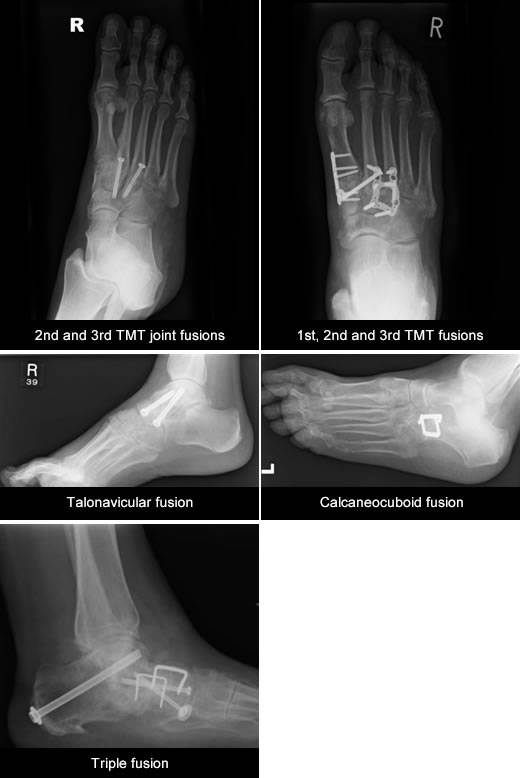in Foot and Ankle Surgery and Reconstruction
The surgeon will have explained that in joints in your foot, i.e. where the bones meet one another, the bone is normally covered by a smooth cartilage lining allowing you to move normally. In people who have, for example, severe osteoarthritis, rheumatoid arthritis or possibly a previous injury the cartilage gets damaged and gradually the joint stiffens and develops arthritis and pain.
This is a permanent joining or stiffening between arthritic bones of your foot. The bones are held together with metal screws/plates that act to stabilise the bones tightly together while your body naturally allows the bones to combine and fuse together.
No. The reason for this is because they bones are already stiff together anyway because of the wear and tear and arthritis between them. In fact the operation is really designed to convert an already stiff but painful joint into a stiff (with screws) but painless joint.
Generally 1 night hospital stay is required. The operation is done under a general anaesthesia and an added injection in the leg to numb the foot for after surgery. The operation in general will involve 1-2 incisions on the foot, depending on the exact joints to fuse together. The procedure involves removing the painful damaged joints and then stiffening the bones together with screws or plates that stay in long term. Occasionally extra bone is needed to help the bones to fuse. This can be taken from your own hip area or knee area or even from sterile supplies of donor bone in the hospital. Your Consultant will discuss this as required. Dissolvable skin stitches are used.

Your foot will be in a plaster cast to the knee, numb and pain free. You will see a physiotherapist who will advise on walking non-weight bearing. You will be discharged only when comfortable with an appointment and pain-killers as required.
Your physiotherapist will guide you through the stages of rehabilitation including gait re-education, swelling reduction and reducing muscle tightness. It is important to adhere to advice given.
Keep the plaster cast totally dry. You may shower with a waterproof cover over the plaster. Once the plaster is removed you may shower if the wound is healed by carefully removing the boot and gently dab the wound dry.
Once out of cast, do not pull at scabs but let them fall away naturally. If your wound becomes red, swollen or sore you need to see your Consultant to ensure there is no infection present. Your physiotherapist may advise on wound massage when its healed.
DVLA states it is the responsibility of the driver to ensure they are always in control of the vehicle. A good guide is if you can stamp down hard with the foot to stop the car in an emergency stop. This will take at least 12 weeks. Click here to read DVLA guidance.
This is very individual and job-dependent. Below is a guide:
Excellent pain relief quite quickly and improving as the joints fuse, which can take 3 months. Good level of activity and sports by 6 months to continue to improve up to 12 months. Fusion operations have excellent outcomes in over 90%. Mild swelling can persist in the foot for up to a year.
Any operation carries a risk. Below is a guide to some risks potentially encountered. It is the surgeons duty to fully inform you of possible risks. Mr Roche will ensure this is always done so patients can make safe and informed choices about their operation.
If this happens, it is usually simply treated with antibiotics. The risk is around 1%. Significant consequences from infection are very rare but can be dealt with.
Nerves that supply sensation to the skin are near the incision site. Damage is rare but if your toe stays numb after surgery, the nerve may be bruised. If so it usually recovers. Risk is 5-10%.
This means the bones fail to biologically fuse. Occasionally it can be “painless” and intervention may not be needed. If painful, then treatment options will be discussed. The risk is 5-10%.
Sometimes the metal can be prominent and once the bones have fused, usually after 6 months the metal can easily be removed with a small day-case operation.
Symptomatic clot formation in the leg is unusual after foot and ankle surgery (<3%). Whether treatment to prevent clot is needed can be discussed with your surgeon. There is no consensus amongst UK Orthopaedic surgeons as to whether preventative medicine is needed.
Certain things may delay or even prevent the bones from fusing together. You must try to avoid them. This includes:
This document is only meant to be a guideline to help you understand your treatment and what to expect. Every person is different and your rehabilitation may be quicker and slower. This will be advised and guided by your doctor and physiotherapist.